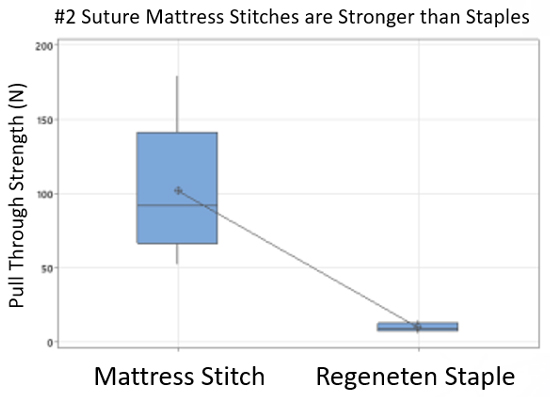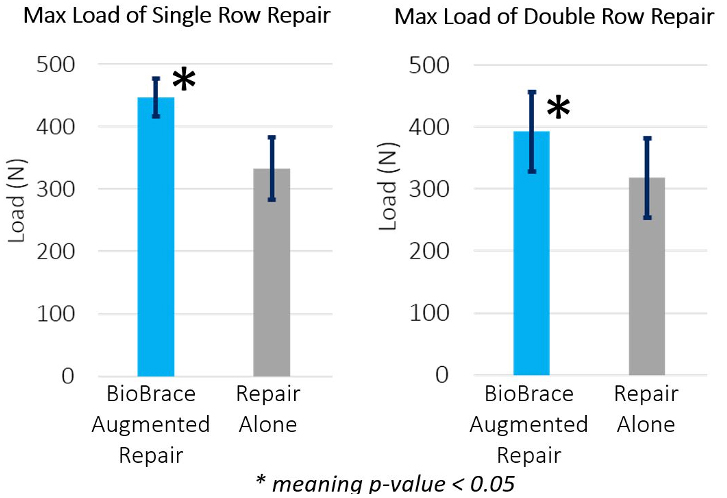Most rotator cuff failures occur within the first 6 months post-operatively. This is well noted in research and literature on rotator cuff repairs:
Suture Fixation Provides Order of Magnitude Strength Improvement Over Tendon Staple Fixation, Enabling BioBrace® Load Sharing
- Published: 6/26/2025
- 5 min
"Since about 80% of the tendon retraction occurs in the first 12 weeks after surgery, these data also suggest that repairs should be protected in the early postoperative period, and repair strategies should endeavor to mechanically augment and improve the rate and quality of the repair in this critical early period."
- McCarron et al 2013. AJSM1.
"Thirteen (61.9%) of the radiographic retears noted in this cohort occurred in the immediate postoperative period leading up to the 3-month follow-up visit... Therefore, the timing of radiographic retears in the current analysis seems to indicate that the key contributor to failure in most cases was a failure to achieve adequate mechanical fixation during arthroscopic repair."
- Bushnell et al 2022. JSES2.
"Retears primarily occur between six and twenty-six weeks after arthroscopic rotator cuff repair, and few additional tears occur thereafter."
- Iannotti et al 2013. JBJS3.
Thus, reinforcing and protecting rotator cuff repairs in the early post-operative period may prevent early post-operative failure of the repairs observed in the literature.
Augmentation of a rotator cuff repair can be performed with certain implants to reinforce rotator cuff repairs at time zero. Adding a reinforced implant on top of a rotator cuff repair can reduce the possibility of suture pulling through the tendon by increasing the strength of the suture-tendon interface. Augmentation devices such as these are traditionally fixated to tendon tissue with suture, as this enables the device to impart its full strength onto the repair construct.


1 McCarron JA, Derwin KA, Bey MJ, et al. Failure with continuity in rotator cuff repair "healing". Am J Sports Med. 2013;41(1):134-141.
2 Bushnell BD, Connor PM, Harris HW, Ho CP, Trenhaile SW, Abrams JS. Two-year outcomes with a bioinductive collagen implant used in augmentation of arthroscopic repair of full-thickness rotator cuff tears: final results of a prospective multicenter study. J Shoulder Elbow Surg. 2022;31(12):2532-2541.
3 Iannotti JP, Deutsch A, Green A, et al. Time to failure after rotator cuff repair: a prospective imaging study. J Bone Joint Surg Am. 2013;95(11):965-971.
4 Test Report Data on File. ConMed Corp. 2025.
5 Walsh, W.R. , Lovric, V, Crowley Rocco K, Batista J, Viswanathan G, Ott JM. 2024. “Mechanical Properties of Augmented Rotator Cuff Repairs Using an Ovine Infraspinatus Model” Presented at the American Academy of Orthopaedic Surgeons (AAOS) 2024 Annual Meeting; February 12-16, 2024, Conference.
6 Walsh, W.R. , Carter, A.J., Lovric V, Crowley J, Wills D, Wang T, Kanski G, Stanton R, Arnoczky S, Arciero R. 2021. “Tissue-Engineered Augmentation of A Rotator Cuff Tendon Using A Novel Bio-Inductive Biocomposite Scaffold: A Preliminary Study In Sheep” Presented at the Orthopaedic Research Society (ORS) 2021 Annual Meeting; February 12-16, 2021, Virtual.
7 Carter, A.J., V. Lovric, P. Morberg, J. Ott, J. Bendigo, J. Komenda, M. Aronson, K. Rocco, S. Arnoczky, and W.R. Walsh. 2021. “Characterization of a Novel Bio-Inductive Biocomposite Scaffold for Tendon and Ligament Healing.” Presented at the Orthopaedic Research Society (ORS) 2021 Annual Meeting; February 12-16, 2021, Virtual.
8 McMillan, Sean et al. “Favorable Early Patient-Reported Outcome Measures and Clinical Retear Rates in High-Risk Rotator Cuff Repairs Augmented with a Reinforced Bio-Inductive Implant at One-Year Follow Up.” Surgical technology international, vol. 45 sti45/1819. 16 Oct. 2024